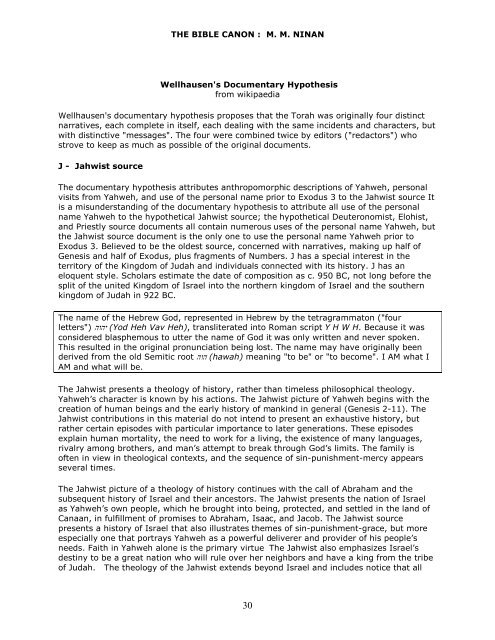Create successful ePaper yourself
Turn your PDF publications into a flip-book with our unique Google optimized e-Paper software.
THE BIBLE CANON : M. M. NINAN<br />
Wellhausen's Documentary Hypothesis<br />
from wikipaedia<br />
Wellhausen's documentary hypothesis proposes that the Torah was originally four distinct<br />
narratives, each complete in itself, each dealing with the same incidents and characters, but<br />
with distinctive "messages". The four were combined twice by editors ("redactors") who<br />
strove to keep as much as possible of the original documents.<br />
J - Jahwist source<br />
The documentary hypothesis attributes anthropomorphic descriptions of Yahweh, personal<br />
visits from Yahweh, and use of the personal name prior to Exodus 3 to the Jahwist source It<br />
is a misunderstanding of the documentary hypothesis to attribute all use of the personal<br />
name Yahweh to the hypothetical Jahwist source; the hypothetical Deuteronomist, Elohist,<br />
and Priestly source documents all contain numerous uses of the personal name Yahweh, but<br />
the Jahwist source document is the only one to use the personal name Yahweh prior to<br />
Exodus 3. Believed to be the oldest source, concerned with narratives, making up half of<br />
Genesis and half of Exodus, plus fragments of Numbers. J has a special interest in the<br />
territory of the Kingdom of Judah and individuals connected with its history. J has an<br />
eloquent style. Scholars estimate the date of composition as c. 950 BC, not long before the<br />
split of the united Kingdom of Israel into the northern kingdom of Israel and the southern<br />
kingdom of Judah in 922 BC.<br />
The name of the Hebrew God, represented in Hebrew by the tetragrammaton ("four<br />
letters") יהוה (Yod Heh Vav Heh), transliterated into Roman script Y H W H. Because it was<br />
considered blasphemous to utter the name of God it was only written and never spoken.<br />
This resulted in the original pronunciation being lost. The name may have originally been<br />
derived from the old Semitic root הוה (hawah) meaning "to be" or "to become". I AM what I<br />
AM and what will be.<br />
The Jahwist presents a theology of history, rather than timeless philosophical theology.<br />
Yahweh’s character is known by his actions. The Jahwist picture of Yahweh begins with the<br />
creation of human beings and the early history of mankind in general (Genesis 2-11). The<br />
Jahwist contributions in this material do not intend to present an exhaustive history, but<br />
rather certain episodes with particular importance to later generations. These episodes<br />
explain human mortality, the need to work for a living, the existence of many languages,<br />
rivalry among brothers, and man’s attempt to break through God’s limits. The family is<br />
often in view in theological contexts, and the sequence of sin-punishment-mercy appears<br />
several times.<br />
The Jahwist picture of a theology of history continues with the call of Abraham and the<br />
subsequent history of Israel and their ancestors. The Jahwist presents the nation of Israel<br />
as Yahweh’s own people, which he brought into being, protected, and settled in the land of<br />
Canaan, in fulfillment of promises to Abraham, Isaac, and Jacob. The Jahwist source<br />
presents a history of Israel that also illustrates themes of sin-punishment-grace, but more<br />
especially one that portrays Yahweh as a powerful deliverer and provider of his people’s<br />
needs. Faith in Yahweh alone is the primary virtue The Jahwist also emphasizes Israel’s<br />
destiny to be a great nation who will rule over her neighbors and have a king from the tribe<br />
of Judah. The theology of the Jahwist extends beyond Israel and includes notice that all<br />
30


















